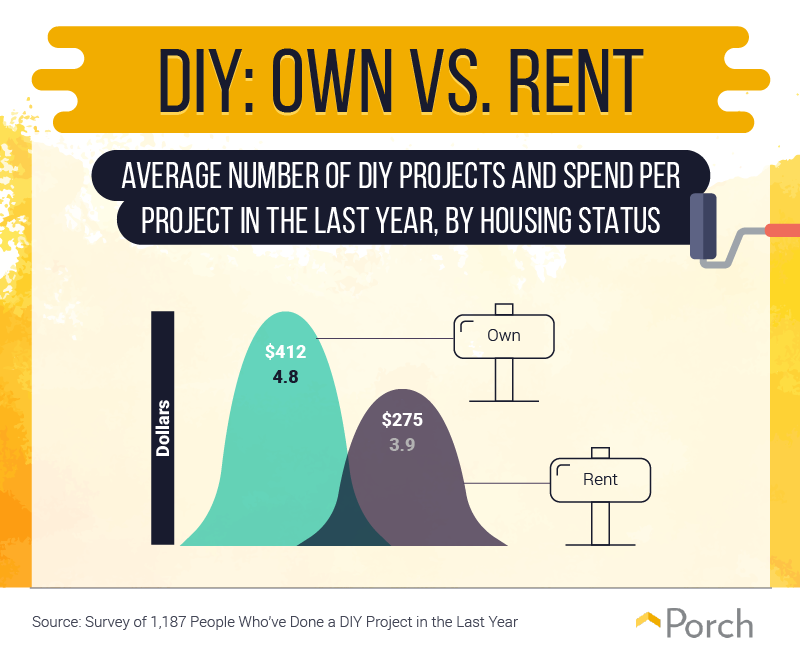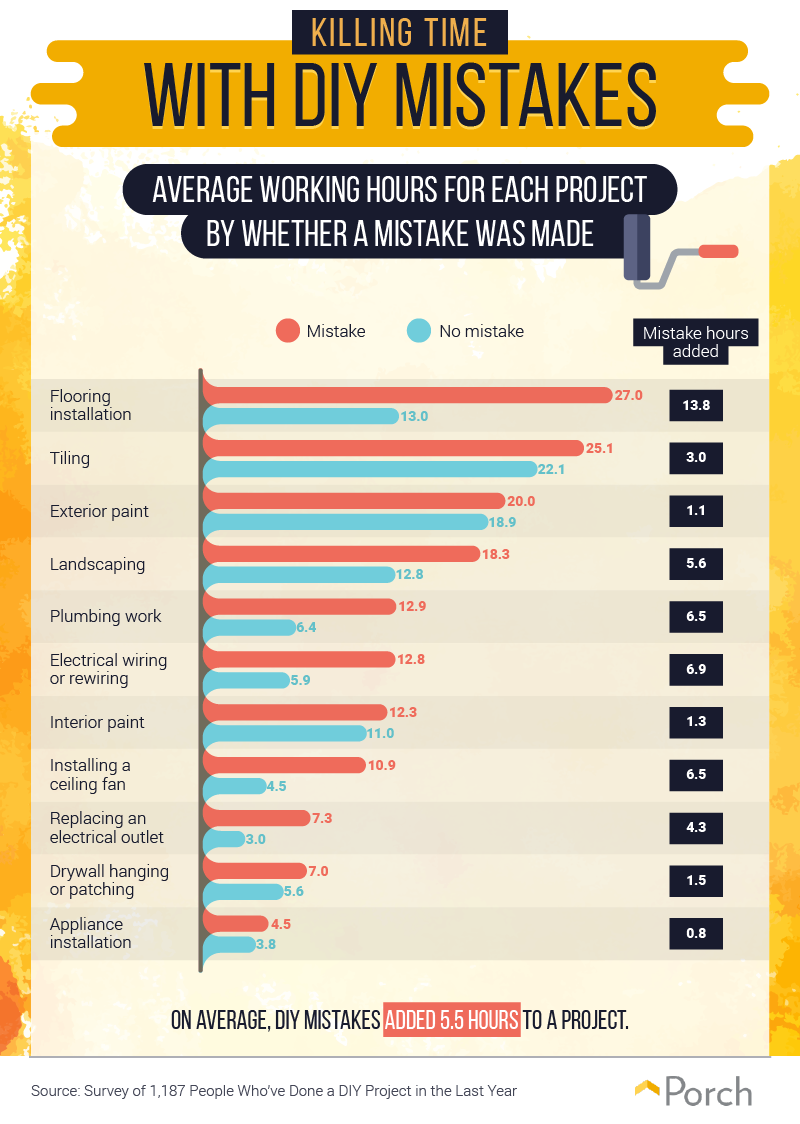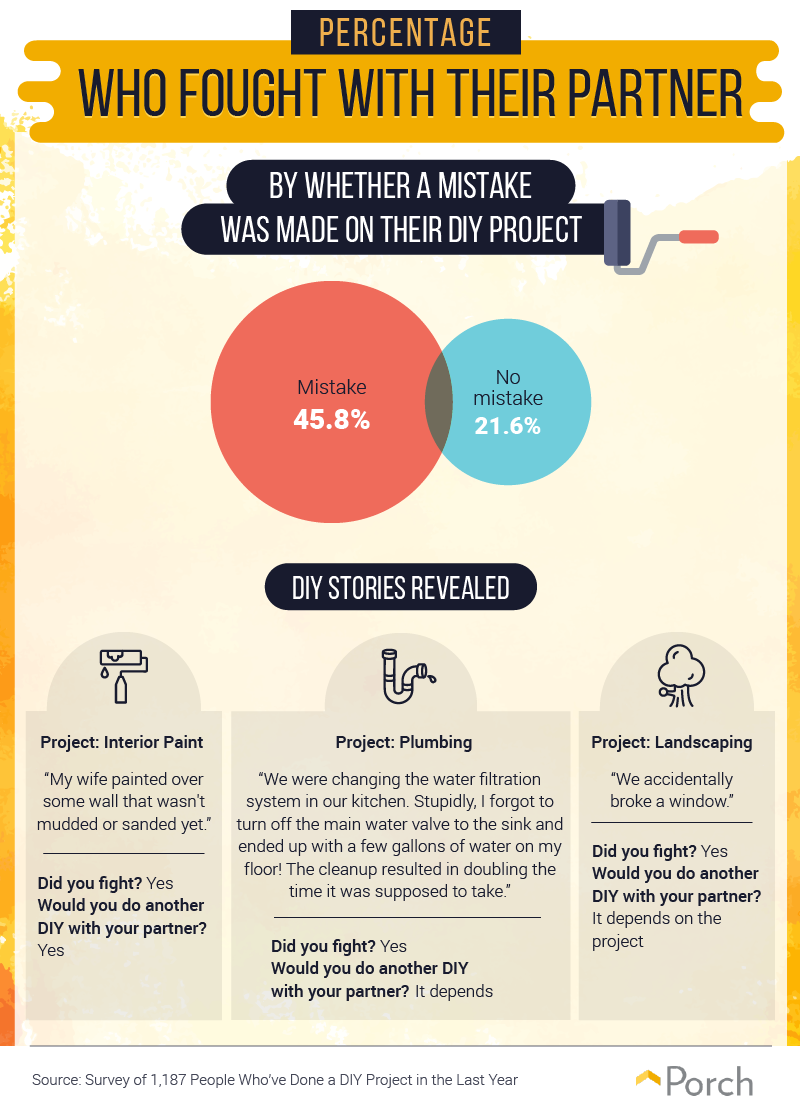For those considering home improvements, the DIY approach promises benefits both financial and personal. Tackling a project yourself can yield serious savings, and successfully completed upgrades are a definite source of pride.
Yet, these advantages depend on favorable outcomes: When DIY goes awry, simple projects can become time-consuming and costly. Moreover, botched jobs can cause conflict at home, leaving loved one pointing fingers at each other. When you consider these possible pitfalls, hiring a professional starts to seem pretty appealing.
How often do DIYers make major errors, leading to added expenses, arguments, and long delays? We surveyed more than 1,000 individuals to find out, learning how they fared with a range of home improvements. Our results show how much time errors can add to basic upgrades and the costs associated with correcting these mistakes. We also studied how projects cause spats between significant others and the stress associated with these incidents. Before you take the plunge on your next DIY project, you’ll want to see what we found out.
Who DIYs and why

Among DIYers, the chief incentive was financial: Roughly a third said they tackled projects themselves to save money. Going DIY can certainly reduce labor costs, although experts urge homeowners to consider the value of their own time as well before starting a new project. For a fifth of respondents, the time commitment was a lesser concern: They opted to DIY because they actually enjoyed the work. Additionally, 17 percent tackled the job because it seemed easy—even though this perception could quickly prove erroneous. Indeed, just 13 percent attempted their project because they already knew how to do it, suggesting most DIYers bring limited experience to their chosen task.
Millennials spent more on DIY projects than their elders, shelling out $405 per job on average. This finding may reflect millennials’ appetite for fixer-uppers: According to one recent study, more than two-thirds would buy a home requiring major repairs. Conversely, baby boomers spent just $331 per project on average and attempted fewer upgrades each year than their younger counterparts. While research indicates that older Americans are plenty handy, baby boomers likely limit the quantity and intensity of their DIY work as they age. Gender differences were also evident, with men spending $50 more per project, on average, than women.
Renter repairs?

One might assume that DIY projects are the exclusive domain of homeowners: After all, renters typically turn to their landlords for major repairs. Yet, our findings indicate that renters often take the initiative of DIY projects, albeit on a smaller scale. Respondents who owned their homes attempted roughly five projects per year on average, spending over $400 on each one. Meanwhile, renters tried approximately four DIY projects annually, spending $275, on average, for each task.
These figures may seem counterintuitive: Homeowners often take on projects to improve the value of their properties, an incentive that renters wouldn’t share. But simple DIY repairs, such as filling nail holes, could help renters get their deposits back. Additionally, plenty of DIY projects aim to personalize a space without making structural changes, such as innovative storage solutions and inventive lighting designs.
Extended by error

On average, respondents who made errors in the course of their DIY efforts took five and a half hours longer to complete the job. But for some especially intensive projects, the time penalty for mistakes was much greater. For flooring installation projects, for example, DIYers who erred took 27 hours, on average, to finish the job—more than twice as long as those who made no mistakes. This figure could reflect the specificity of flooring products and related procedures: Hardwood, laminate, and vinyl are all installed differently, and early errors can cause major issues down the line.
Projects involving electrical work could also be punishing for those who made mistakes. When working with wiring or installing a ceiling fan, individuals who made errors needed more than twice as much time. Moreover, the stakes are quite high when dealing with wiring: Basic errors can imperil whole homes by causing electrical fires. Other tasks were more forgiving to the imperfect DIYer. Exterior and interior paint jobs were extended by roughly an hour for those who made a mistake. Likewise, appliance installations were delayed less than an hour by errors.
More problems, more money

If flooring errors were typically time-consuming, the costs of correction were massive as well. On average, respondents who made mistakes spent $829 more to finish installing their floors. This cost differential likely reflects the price of the materials involved: Hardwood can cost homeowners thousands, and poorly laid boards may need to be replaced. Conversely, tiles can be laid out before any grout goes down, preventing the need to rip them out later. Accordingly, individuals who made mistakes when installing tile paid just $58 more on average.
Errors in exterior paint jobs were typically quite costly, dinging DIYers for an additional $447 on average. This cost could reflect problems in selection rather than execution: Homeowners sometimes overlook factors such as natural light and have to start over with an entirely new color. Mistakes in replacing electrical outlets could also be expensive, costing DIYers $445 more, on average, than successful jobs. Interestingly, however, the costs associated with other electric errors were significantly lower, including those for wiring jobs and ceiling fan installations.
DIY vs. dating

Married respondents attempted slightly more DIY projects each year than those who were single or in relationships. They also spent more freely, shelling out $479 per project on average. This result could reflect the connection between marriage and the costs of homeownership. Many wait to purchase property until after they tie the knot (although millennials are bucking this trend to some extent).
Yet, single folks also spent more money on DIY projects than people in relationships. Perhaps, in the absence of a partner, they have more time to attempt ambitious upgrades. But these findings could also reflect the financial strain of affording a home without a partner. With a single income to afford the mortgage, saving money through big DIY projects could be especially appealing.
DIY disagreements

For respondents who were married or in relationships, fights over DIY projects were relatively common. Electrical wiring projects were primed to produce conflict: 44 percent of attempts resulted in an argument. Squabbles also occurred quite frequently for individuals replacing electrical outlets or installing ceilings fans. Perhaps the prospect of getting shocked increases the tension in these instances. One partner might wish to plunge ahead, while the other urges them to stop in the name of safety.
At the other end of the spectrum, appliance installation caused couples to fight in just 17 percent of cases (perhaps because clear instructions typically accompany new devices). Plumbing projects also had low rates of conflict: Only 1 in 5 included an argument. Furthermore, some low-conflict projects seemed perfect for couples to attempt together, such as interior painting. A fresh coat of paint could accompany important shared milestones, such as moving in together or transforming a room into a nursery.
Significant others, sources of stress

As one might imagine, our respondents’ errors raised the odds of an argument. Among those who made a mistake, 46 percent squabbled with their significant others while working on the project. By contrast, arguments occurred in just 22 percent of projects that went smoothly. The dynamics at work in these conflicts are understandable: Frustrated by a lack of success, one partner could react defensively to the other’s criticism, lashing out in the process.
Stress was also a clear precursor of couples’ conflict. Unfortunately, these clashes can increase the degree of stress experienced by both partners, ratcheting up tensions in a counterproductive cycle. According to couples therapists, the stressors inherent in renovations are a common cause of strife between partners. And while most couples get over the temporary drama, some do decide to part ways after home improvement conflict exposes underlying issues.
The pros of hiring a pro
Our findings suggest that many DIY projects are quite successful, producing significant savings and real improvements for those brave enough to attempt them. Yet, our data also demonstrate the perils inherent in these undertakings, particularly for large-scale projects. For the excessively ambitious, a single mistake could take hours to address or cost hundreds of dollars to undo. Accordingly, it is incumbent on homeowners to thoroughly research their options, weighing the risks and rewards of attempting each project. With a clear understanding of the costs, time requirements, and common problems, you can make a prudent decision about which projects to tackle yourself.
If you’re looking for this kind of information, Porch is the perfect source. We offer comprehensive project cost guides, so you can see what professionals typically charge for each kind of upgrade. If you decide to hire a pro for any project from TV mounting to window replacement, we’ll connect you with trusted experts in your local area, allowing you to compare real quotes quickly. With affordable offers from trusted professionals near you, there’s no need to roll the dice on doing the job yourself.
Methodology
We collected 1,187 responses for our survey using Amazon’s Mechanical Turk service. Respondents were individuals who had completed a home improvement project within the last year. Home improvement projects included changing outlets, kitchen or bath remodeling, fixing plumbing, install a ceiling fan, and other undertakings of this type.
Limitations
The data we are presenting rely on the survey respondents reporting data about themselves. Data that are self reported can have issues which include the following: selective memory, telescoping, attribution, and exaggeration.
Sources
- https://www.cnbc.com/2018/11/12/how-to-decide-if-you-should-diy-home-improvement-projects.html
- https://www.usatoday.com/story/money/personalfinance/2018/10/22/diy-project-questions-ask-before-home-improvement/1618870002/
- https://www.cnbc.com/2019/01/22/property-brothers-advice-for-the-68-percent-of-millennials-who-would-buy-a-fixer-upper.html
- https://www.aarp.org/home-family/your-home/info-2018/diy-boomer-millennial-survey.html
- https://homeguides.sfgate.com/responsible-repairs-tenants-landlords-63818.html
- https://www.investopedia.com/articles/mortgages-real-estate/08/diy-home-projects.asp
- https://www.hgtv.com/design-blog/design/10-of-our-favorite-diys-for-renters
- https://www.forbes.com/sites/juliadellitt/2018/06/20/why-you-need-to-adjust-your-monthly-budget-for-home-maintenance/#461175af34a0
- https://www.today.com/home/tips-diy-flooring-projects-everything-you-need-know-t136379
- https://www.thespruce.com/common-electrical-mistakes-homeowners-make-1152376
- https://www.thespruce.com/install-ceramic-tile-4173806
- https://www.consumerreports.org/exterior-paints/the-right-exterior-paint-color/
- https://www.cnbc.com/2018/07/27/millennials-might-be-waiting-to-get-married-but-many-are-still-buying.html
- https://www.forbes.com/sites/zillow/2018/02/12/singles-can-afford-fewer-than-half-of-u-s-homes-and-its-worse-for-women/#46240ab5234c
- https://www.thespruce.com/do-your-own-electrical-repairs-1821520
- https://www.psychologytoday.com/us/blog/how-be-yourself/201805/how-stop-getting-defensive
- https://www.verywellmind.com/the-toll-of-conflict-in-relationships-3144952
- https://www.businessinsider.com/couples-fight-during-home-renovations-2018-2
Fair use statement
If you’d like to use our work on your own site or social media, we ask that you observe two simple rules. First, please use this content exclusively for noncommercial purposes. Second, please attribute our team properly with a link back to this page. After all, this work is our very own DIY project, and we definitely take pride in it.

